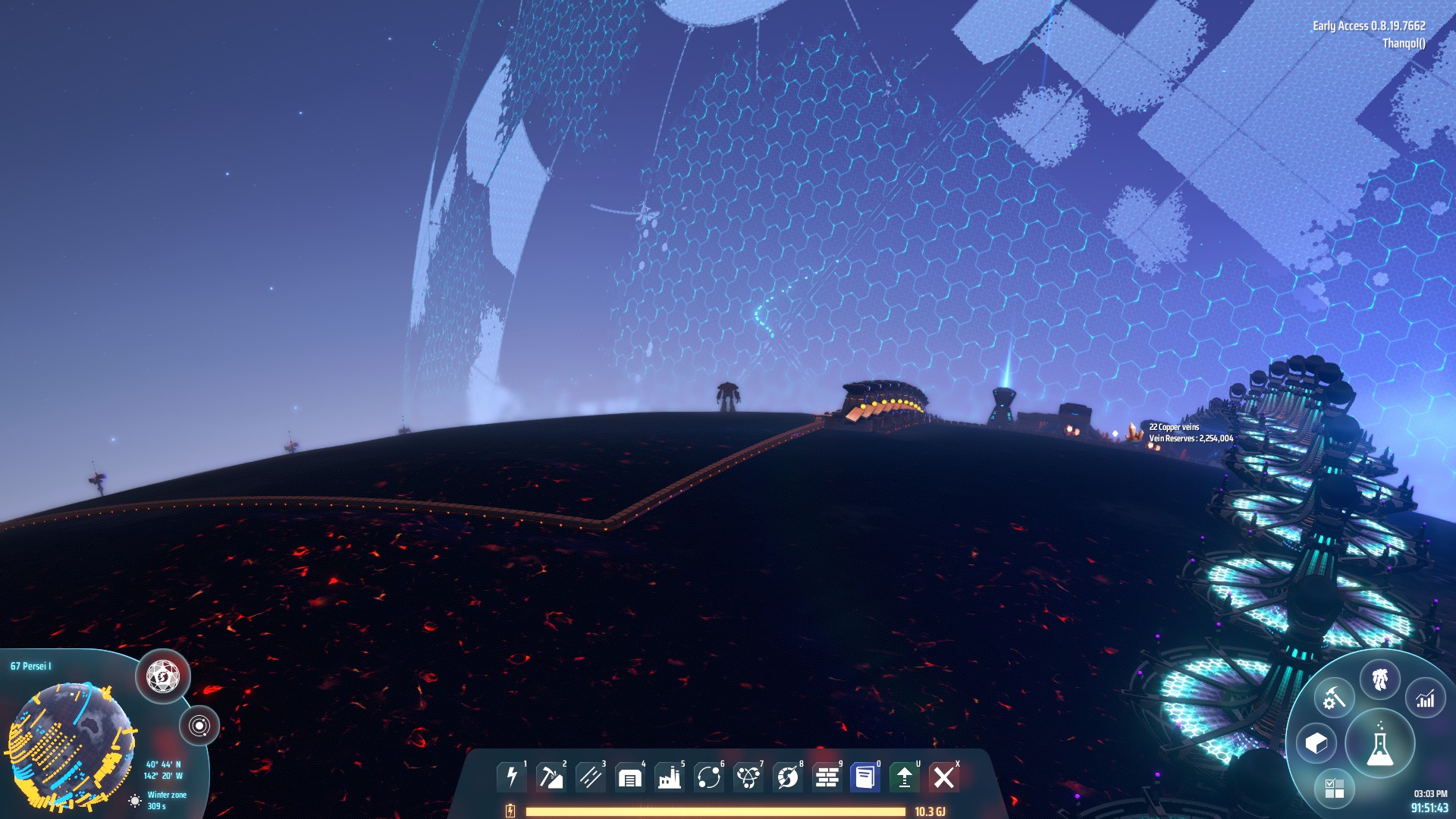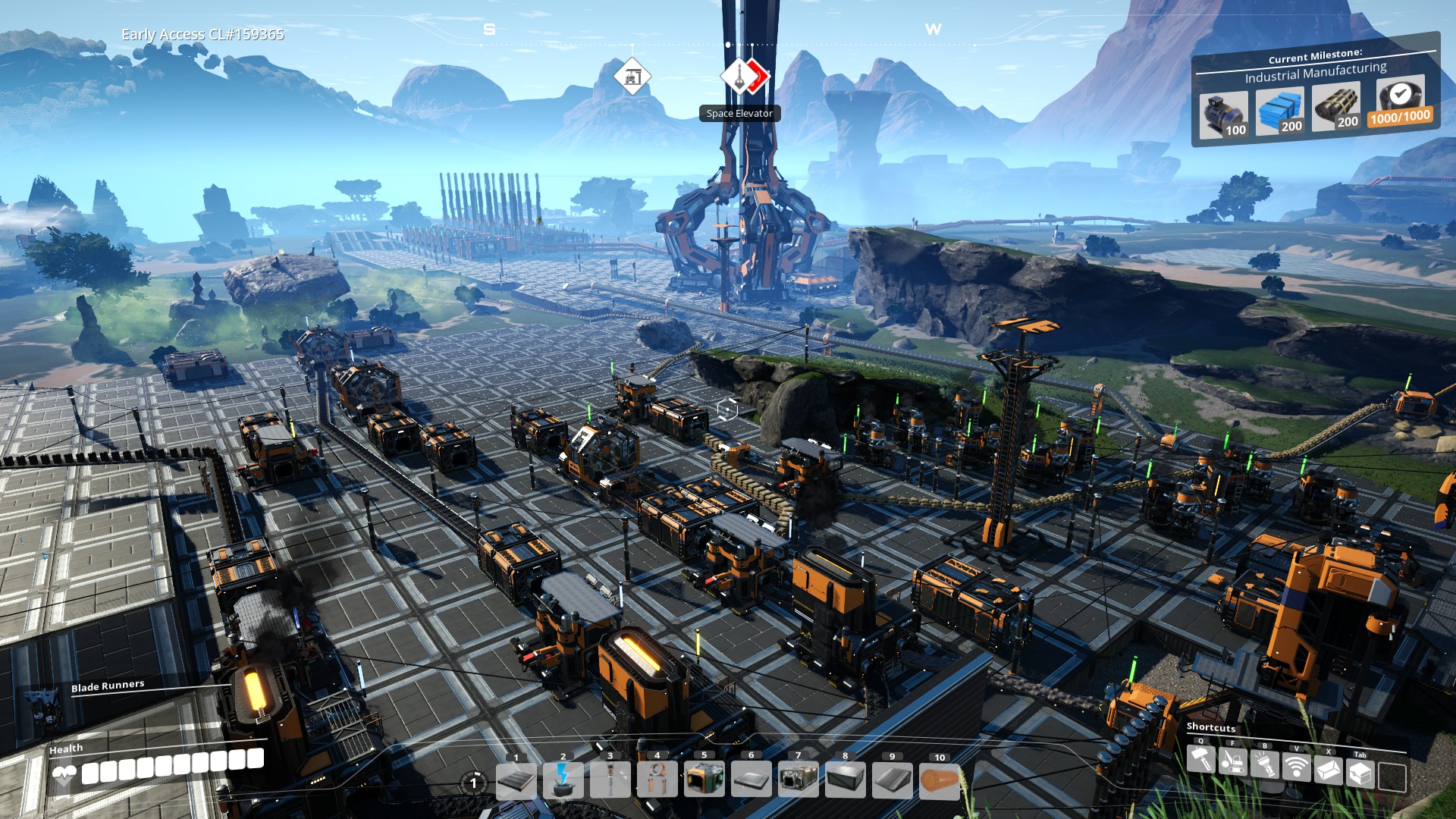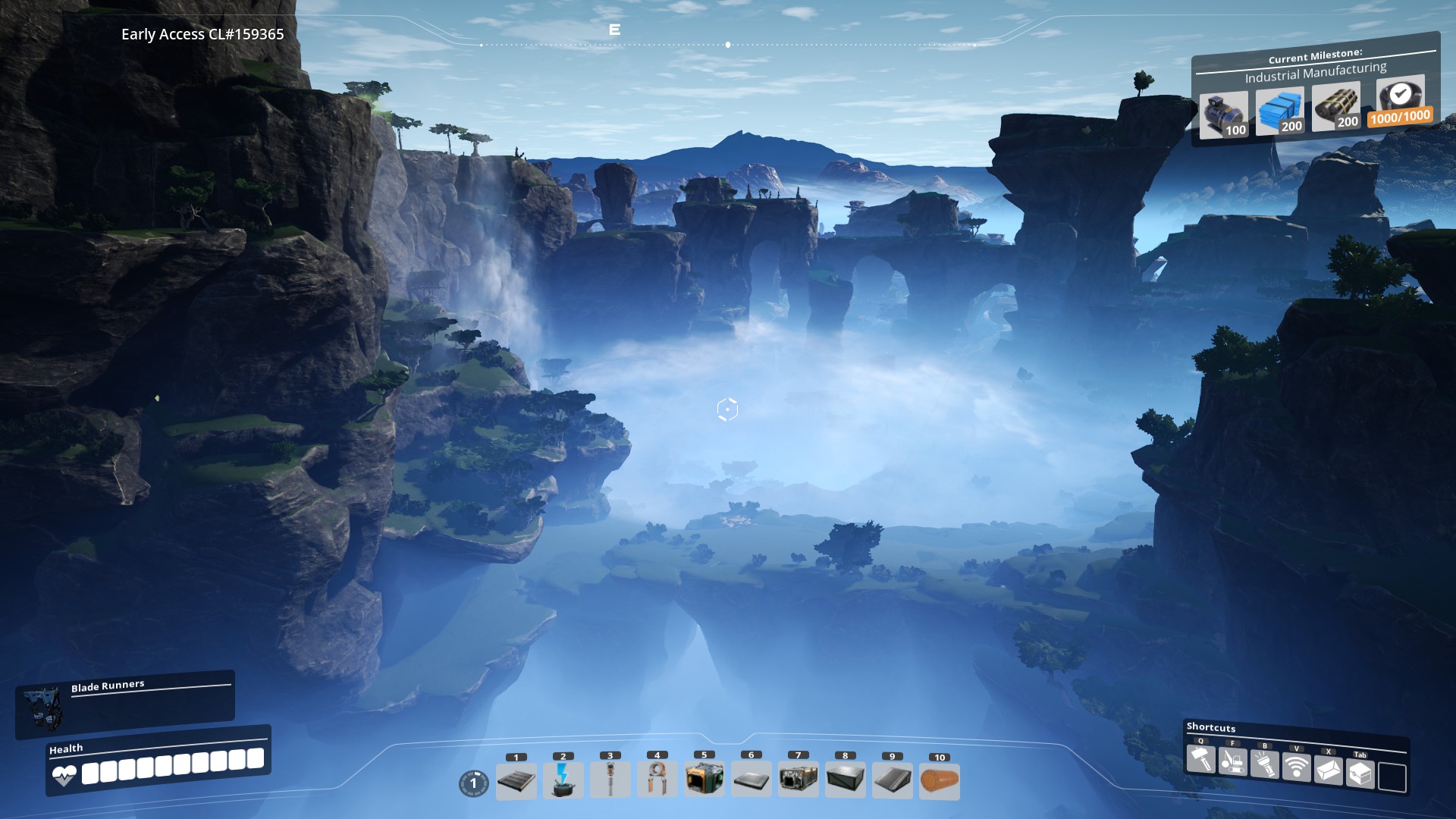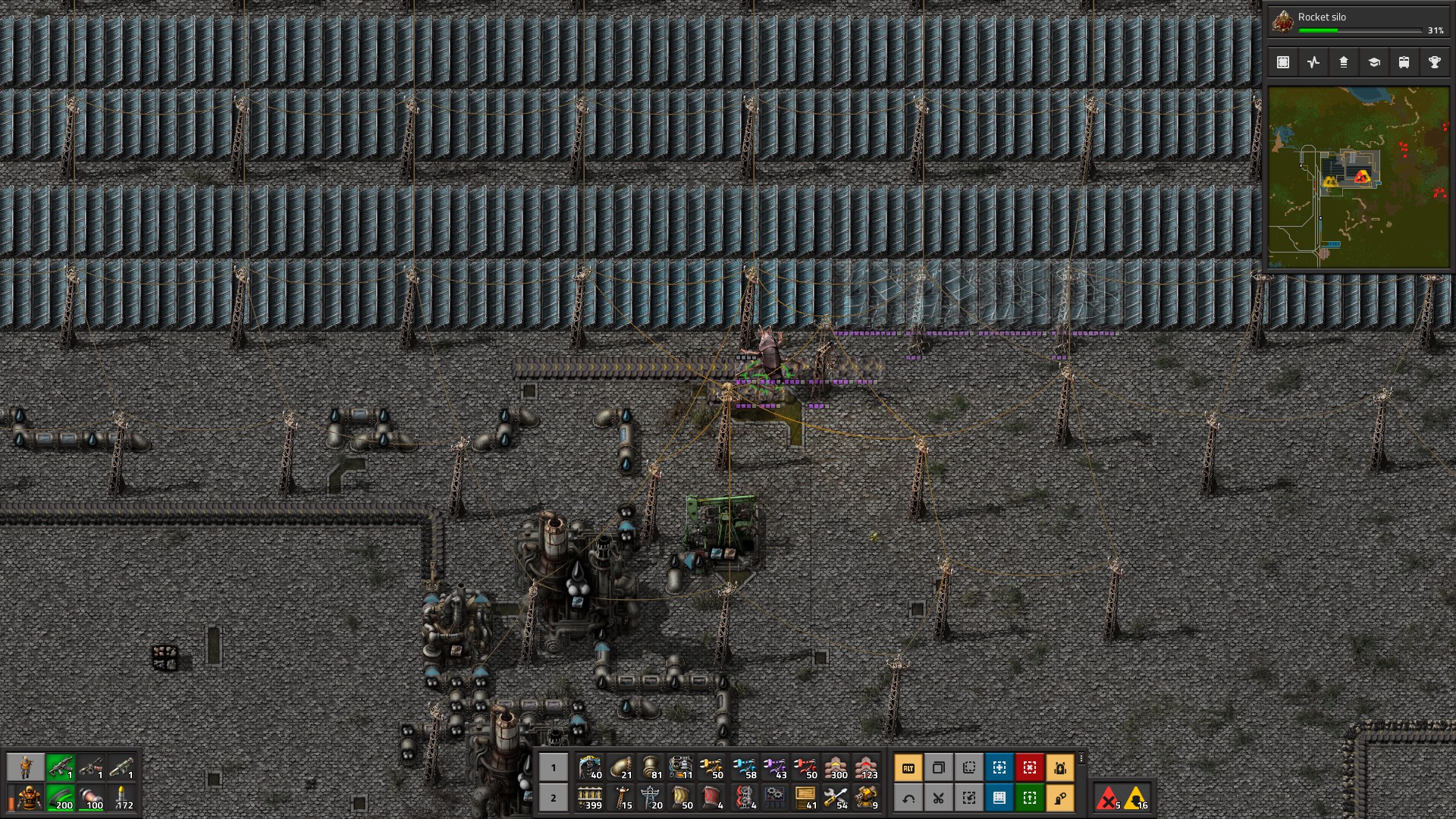This is a triple threat review of Factorio, Dyson Sphere Program, and Satisfactory.
Factorio
Factorio burst onto the scene in 2016 with an innovative take on the management sim genre that was so well received it has since inspired two successors, both currently in early access but sufficiently developed to make them both extremely playable. All three games are excellent and I unreservedly recommend them all at five stars – and that is a remarkable accomplishment in itself – but what I want to talk about here is the ways in which three games with the same basic idea manage to be so utterly different. At the core of each game is an assembly line process by which you turn iron ore into Science Cubes but the feel, vibe, and essential structure of the games are each profoundly divergent in such a way that it highlights the strengths of the other games in the trio by comparison.
Factorio is the original and by far the darkest and most hostile. It was initially recommended to me as the thematic opposite to Stardew Valley – a tense, stressful experience where nothing was ever settled and failures cascade. The key feature in all of this is the point of and pressure on a Factorio factory – the bugs.
Factorio can be taken as an allegory for coding. You create elaborate structures and logic gates and optimization flows but as your system’s complexity increases so to do the number of bugs that creep in. The bugs are infinite, unrelenting, and inevitable – if you leave even the most advanced Factorio complex running for long enough sooner or later the bugs will consume and destroy it utterly. The bugs send out spawners, expand and colonize, and respond to the pollution generated by your industry by sending waves of unrelenting monsters to breach your walls and shatter your complex. The planet hates you and never lets you forget it, constantly pressuring new and unexpected angles looking for chinks in your defenses. It’s no wonder that the game’s ultimate objective is to build a rocket ship and fucking leave.
With the bugs as constant pressure and no way to live in harmony with them then the task of industrial procurement turns to warfare. You are the start of a logistics chain that takes iron ore in the one end and puts artillery shells onto alien hives at the other. In the beginning you’ll sweep nests by yourself with flamethrowers, guns and tanks but by the end you’ll have a blueprint that connects a self-contained artillery base to the end of your rail line that can destroy every nest within range. You can do it with lasers, with rockets, from the top of a giant spider mech, but the inevitable message of Factorio is that all of this wonderous industry is only really good for killing fucking bugs!
The bugs have two advantages: finite resources and only needing to succeed briefly. The most dire situation in Factorio is when one of your mining bases runs out of raw materials without you noticing. When an extractor runs dry then it sends a cascade of failure through your entire factory. Just-in-time supply lines hiccup. Overall production drops. Arms manufacturing slows. A few missed bullet production cycles for a base under pressure by the bugs might let some get close enough to punch a wall a single time before it dies. And once that state is reached then with a drip-drip-drip inevitability it’s only a matter of time before the bugs crack that wall, smash your turrets, and run rampant inside the base. And once they’re in there’s nothing to stop them until they hit your defenses on the other side of the complex. Your whole carefully built killing machine is left in ruins and the bugs move in to colonize the remains. You can rebuild, of course, but to rebuild you need those same scarce resources whose depletion led to the disaster in the first place, and to get them you need to push further out into the infested world.
It’s this sense of timing and pressure that pervades Factorio and makes it, for me, ultimately a miserable experience. If your train timetable and signal network isn’t set up correctly they’ll collide and leave you ruined. If you spend too long on the wrong side of the map from a sprawling complex and get a damage notification that there’s a problem on the other side there you need to race over, clear any bugs, throw up emergency defenses, and then troubleshoot your own tangled spaghetti code. All of your sins are inescapable, a single broken module or unexpected bottleneck will exact its price in insufficiently dead bugs. The planet wanted me to leave, to just say ‘fuck it’ and accept a transfer to another job and abandon all of my nightmarish, compromised and inelegant conveyor lines to collapse back into the sand. So eventually, I did. This too is a allegory for coding.
Dyson Sphere Program
 So what a relief it is to play Dyson Sphere Program after burning out on Factorio. The twist is simple, obvious even: There are no bugs. You start the game piloting a mecha that would have taken all the resources of an endgame Factorio complex to even construct. It would seem like a frictionless game except for the immensity of your task: single handedly construct a megastructure large enough to chain a sun.
So what a relief it is to play Dyson Sphere Program after burning out on Factorio. The twist is simple, obvious even: There are no bugs. You start the game piloting a mecha that would have taken all the resources of an endgame Factorio complex to even construct. It would seem like a frictionless game except for the immensity of your task: single handedly construct a megastructure large enough to chain a sun.
The early game of Dyson Sphere program plays similarly to Factorio. Sorting out your basic mining and refining, cludging together ugly little modules of science cubes in sprawling and haphazard little arrays. The other side of the planet seems an impossible distance and you’re constantly harvesting wood to hurl into your engine’s hungry mouth. But Dyson Sphere Program is a game of firsts. Eventually you’ll hit a bottleneck and to proceed you need titanium ore which is not present on your starting planet. So you’ll pack your inventory, do a last troubleshooting check on your industry lines, take a deep breath – and jump.
The first time you jump into space is one of Dyson Sphere Program’s magical moments. You launch yourself up into the void and your planet fades away and it’s seamless. There’s no boundary or loading screen, your entire factory complex vanishes into irrelevance as you set sail into the void. Soon enough you’ll land on one of your system’s other planets and set up an extraction based resource colony, and you’ll manually ferry the titanium back yourself. These first tentative steps off the homeworld have the feeling of running a space program, and as you work your colony will go from a mining outpost to an industrial hub in its own right. As new technologies trickle in the logic of your bases and resource requirements will change and soon it’ll be time to abandon your messy and tangled homeworld entirely and move your operations permanently to a richer world.
The first time you warp between systems is the second paradigm shift in Dyson Sphere Program because it heralds a transition to a new type of civilization. At this point the true nature of the game becomes clear: the biggest problem you face is legibility. You can have a hundred factories on a hundred worlds churning out resources but they’re all fucking useless if you have to go get them yourself. Your task is way too big to keep returning to the same worlds over and over to sort out glitches and shortages. You need to create a production line, make it so you can harvest the resources of that production line from anywhere in the galaxy, and then leave that world possibly forever. You’re building a Dyson Sphere, after all.
But so too can you linger, if you want. There’s no time pressure in Dyson Sphere Program. You can just stop for a while and observe a beautiful galaxy. You don’t need to build your Dyson Sphere as a sphere either, you can put some artistry into your design. After a certain point you don’t need the project for the electricity it generates, it can exist on its own merits as a piece of galactic art.

To aid in this legibility, Dyson Sphere Program lets you plug resources into planetary logistics centers – enormous space elevators – and be able to request delivery anywhere you need. Once resources are in the logistics system then they’re logistics that you own in a way that you don’t own resources stuck in stockpiles on a planet you’ve already forgotten the name of. You’ll land on planets, set up mining and basic refinery infrastructure, plug it all into the logistics system and have the materials delivered to your industrialized forge worlds. You’ll never need to revisit your forge worlds because they’re not reliant on local materials; as long as there’s iron in the system it’ll find its way to where you’ve told it to go. The goal is to create abundance, infinite abundance – to have infinite quantities of every resource available and on hand. You’ll need them all. In a cascade of rocket launches and an endless barrage of ion cannons, you’ll fire all of those infinite resources into space until together they blot out the sun.
Satisfactory
The final game in this series is Satisfactory. It’s a first person game, it has an emphasis on exploration, but what’s really interesting for this discussion is the different demands it places on you compared to the other two games. In Factorio, you’re optimizing your factory to prevent failures, because a failure can compound into catastrophe. In Dyson Sphere Program, you’re optimizing your factory for legibility, accepting any inefficiencies as the cost of building a structure larger than the sun. In Satisfactory the key demand on your attention is efficiency.

This is not least because of the demands of a first person viewpoint. It’s a fundamentally inefficient and awkward way to do base building. With the other two games you can lay down the blueprints and the drones will swarm out and the conveyor line will be built without much planning. When you’re having to fix every pipe connection and power line yourself then the process slows a lot. Resource nodes are far apart and overland logistics are awkward to establish – even a simple truck delivery you need to set aside a huge swathe of space and program the route yourself, and that’s for a one-way delivery. Everything takes time, and even then you’ll hit hard caps on your development. You may have three coal mines but their maximum output is ultimately throttled by the speed of the conveyor belts leaving the buildings. So, you only have so much coal per minute – how to get the most use out of it? How to make sure it ends up in places convenient to access? Compared to the planet-wide megaplexes of Dyson Sphere Program, my Satisfactory manufacturing hub is weirdly small even though I’m well into the midgame.
The exploration in Satisfactory is a major draw, the landscapes and wildlife are beautiful, and simply seeing new things is its own reward – but the actual reward is more efficiency. Power slugs make buildings consume and produce more, letting you cram more assembly line into a smaller space. You might find alternate recipes – one of my favourite treasures is a way to produce screws out of iron ingots without having to forge them into iron bars first, letting me skip a step on my assembly lines. Even building vertically seems like a good idea in Satisfactory, a concept alien to the vast horizontal sprawls of the other two games – keeping a compact and tidy factory means everything is easy for you to access, and less technically involved materials can be pushed out to the periphery.

Perhaps because of the inefficiencies involved in doing everything, the milestones in Satisfactory are far more satisfactory than the technological shifts in other games. You can perceive an increase in capabilities or a decrease in friction in an extremely immediate sense – learning how to make parachutes or running augments or a jetpack changes your basic interaction with the map. You feel yourself becoming stronger, faster and more useful with each new tier and success. Where the ultimate output of the vast industries of Factorio are mountains of dead insects, and the end state of Dyson Sphere program is the titular Dyson Sphere, all of those resources in Satisfactory are re-invested right back into you. You’re building better ways for you to move around the map, for you to explore its secrets, for you to appreciate this beautiful world you find yourself in before you convert that fertile earth into a furnace for churning ore.
Have any questions or feedback? Drop us a note in the comments below or email us at contact@goonhammer.com.



